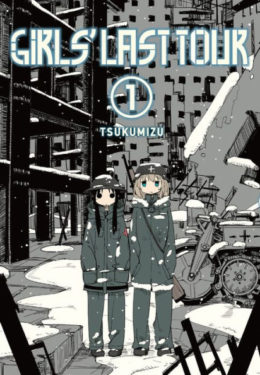Everyone loves a tale of plucky underdogs contending against seemingly overwhelming odds. Take, for example, Tsukumizu’s Girls’ Last Tour (Shōjo Shūmatsu Ryokō), a manga serialized from 2014 to 2018 in Shinchosha’s Kurage Bunch online magazine and later collected in six volumes.
Sisters Chito and Yuuri were born into a world scoured by war, a ruined cityscape where humanity is rare and becoming rarer. Forced to flee their home, the youngsters spend their lives driving from one enigmatic location to the next on their beloved Kettenkrad1 , searching for food, necessary supplies, and answers.
The logical move might be to flee to some pristine wilderness, but it seems that before humans turned on each other, they Trantor-formed the Earth. It’s a totally Anthropocene Earth, where every accessible region has been transformed by human vision. While this is a grand achievement, the civilization responsible does not appear to have worried about what would happen if, one day, the machine stopped.
Lacking a fabled Arcadia to serve as a goal, Chito and Yuuri follow their grandfather’s advice to explore upward. The lower levels may have been picked clear by survivors living in the ruins, but the upper levels might prove more friendly.
Or, you know… perhaps not.
“Two prepubescent girls equipped with cut-down military gear attempt to delay their inevitable demise by scrounging amidst the ruins for the basic necessities of life” probably sounds like the sort of fiction sought out by parents worried that Old Yeller and The Red Balloon are far too upbeat2 . Yet somehow, although it is clear that Yuuri and Chito’s long-term prospects are dim, and that humanity is effectively extinct, Girls’ Last Tour somehow manages to be a curiously life-affirming, comforting series.
Buy the Book


Girls’ Last Tour
In large part, this is thanks to its two inseparable leads, who don’t obsess on their obvious mortality. Chito is an insatiably curious bookworm, while her intellectually unburdened sister Yuuri focuses on more immediate pleasures like food. Aside from two strangers who vanish almost as soon as they appear, the sisters spend the entire series in solitude, but they do have each other. Their world may be horrible, but it is also full of wonders that the sisters take the time to savour.
The series is well served by its spare but effective art, which conveys the sense of a world plated over and then abandoned by its foolish creators.
Girls’ Last Tour is an instance of the genre the Japanese call “iyashikei”; episodic slice-of-life stories with little to no conventional dramatic conflict, stories with an overall soothing effect. A post-apocalyptic wasteland might seem like an odd choice for an iyashikei story (unless you’ve encountered Yokohama Kaidashi Kikō), but Girls’ Last Tour is proof that it not only can be done, but done well.
Girls’ Last Tour is licensed in North America by Yen Press.
In the words of Wikipedia editor TexasAndroid, prolific book reviewer and perennial Darwin Award nominee James Davis Nicoll is of “questionable notability.” His work has appeared in Publishers Weekly and Romantic Times as well as on his own websites, James Nicoll Reviews and Young People Read Old SFF (where he is assisted by editor Karen Lofstrom and web person Adrienne L. Travis). He is surprisingly flammable.
[1]The manga is clearly set in the far future. We never get an explanation why the kids have what is either an antique (incredibly antique) vehicle or a replica of an ancient device.
[2]Yes, I am still bitter about that particular first grade double bill.










I don’t need to know why the girls have a Kettenkrad. Kettenkräder are cool and I want one.
Yes, I am still bitter about that particular first grade double bill.
Sheesh. Did they follow it up with Grave of the Fireflies the day before Christmas Break?
Just read the Wikipedia entry on The Red Balloon, which is new to me. Good god why would anyone do this to first-graders????
@1 Patrick Morris Miller:
Correct. Kettenkräder satisfy the Rule of Cool, so they are allowed.
(Can I figure out how to put a Flickr selfington into a Tor comment? Let’s see!)
(Several bungled drafts later: No.)
Well, I could give up and just link to it.
@3 My freakin’ elementary school showed the video every year. Thankfully I only had to see it in grades 4-6.
My other peeve is my summer camp director insisting on reading the Giving Tree every summer. There’s got to be a better text to promote collaborative work rather than female tree gives all to selfish boy.
I was in the middle of reading Old Yeller when my sister told me how it ended.
I love the cover art on this.
2 No but probably the only things stopping them was Ontario schools in the 1960s were pretty racist and unlikely to show something set in Japan, and also GotF wouldn’t be made for another 20 years or so.
Does the manga make it clear that they’re sisters? The anime doesn’t mention it aside from them both talking about “grandfather” (who need not be actually related to either of them, given context).
Yes, there’s an anime.
https://www.youtube.com/watch?v=mF5MKNwbRhg
I notice there is an anime version of this on Amazon Prime, I’ll have to take a look.
I feel happy I knew what a Kettenkrad was already, from Charles Stross’ Laundry Files books.
We saw Red Balloon in school (and maybe church or camp) several times. Of course the thing about 16mm film, in the classroom, is there were a lot less films to choose from than there would be videotapes or dvd’s later on, so you tended to see things more than once…